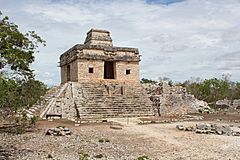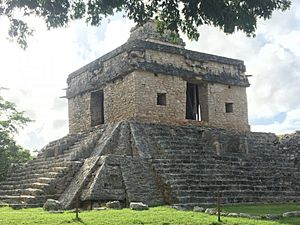Dzibilchaltun facts for kids

Temple of the Seven Dolls at Dzibilchaltun
|
|
| Location | Yucatán, Mexico |
|---|---|
| Region | Yucatán |
| Coordinates | 21°5′27.60″N 89°35′25.08″W / 21.0910000°N 89.5903000°W |
| History | |
| Cultures | Maya civilization |
Dzibilchaltún (pronounced dzee-beel-chal-toon) is an ancient Maya city. It is an archaeological site in the Mexican state of Yucatán. This amazing place is about 10 miles (16 km) north of Mérida, the state capital. The original Maya name for this city might have been Ch'iy Chan Ti'Ho.
Contents
Exploring Dzibilchaltún: An Ancient Maya City
Dzibilchaltún is a fascinating ancient city built by the Maya people. It has been lived in for thousands of years. Over time, it grew into a busy city and then sometimes became a smaller town. Today, it is an important place to learn about Maya history.
Why Dzibilchaltún Was Built Here
The ancient Maya builders likely chose this spot for their city very carefully. They wanted to be close to the coast where salt was made. Salt was a very important trade item. The area between Dzibilchaltún and the sea was not good for living. It had swamps or rocky land. So, Dzibilchaltún was built in the best possible place.
What We Know About Dzibilchaltún's Rulers
Many stone monuments, called stelae, are found at Dzibilchaltún. These stelae often told stories about kings and important events. While many of them are worn down, we know that at least one king ruled here. His name was K'alo'mte' Uk'uuw Chan Chaahk. His story was carved on Stela 10.
Amazing Buildings at Dzibilchaltún
The most famous building at Dzibilchaltún is the Temple of the Seven Dolls. It got its name because archaeologists found seven small clay figures, or effigies, inside it. These figures were discovered in the 1950s when the temple was found hidden under another pyramid.
The Temple of the Seven Dolls and the Sun
Many visitors come to the Temple of the Seven Dolls during the spring equinox. This is when day and night are almost equal in length. People gather to watch the sunrise through the temple's doorways. However, experts have not found any special markers that show the Maya built it for this purpose.
The White Road: A Maya Highway
The Temple of the Seven Dolls is connected to the rest of the city by a sacbe. This word means "white road." These roads were special pathways built by the Maya. They were made of stone and rubble, then covered with white limestone. This made them stand out and look like ancient highways.
Nature and History Around Dzibilchaltún
Another key feature of Dzibilchaltún is its cenote. A cenote is a natural sinkhole filled with fresh water. The one here is called Cenote Xlakah. It is located right in the middle of the city's ruins.
Cenote Xlakah: A Source of Life and History
Having clean drinking water from Cenote Xlakah was likely a big reason why the Maya built their city here. Divers have explored the cenote and found many ancient objects. These findings suggest that the cenote was a very important place for religious ceremonies. The cenote was once a popular swimming spot. It is currently closed for maintenance and due to concerns about water quality.
Treasures from the Cenote
Just like at other famous Maya sites such as Chichen Itza, many archaeological treasures have been found in this cenote. These include carved bones, wooden objects, and many ancient vases. These discoveries give us valuable clues about the daily lives and beliefs of the ancient Maya people who lived near Dzibilchaltún.
A Glimpse of Spanish History
Dzibilchaltún also has the ruins of a Spanish church. This church was built in the 16th century, after the Spanish arrived and took control of the area. It shows how different cultures came together in this ancient place.
Visiting Dzibilchaltún Today
The Dzibilchaltún archaeological site has a visitor center. Here you can find maps, restrooms, and gift shops. You will need to leave backpacks and similar items in lockers, as they are not allowed inside the site. Guides are available to hire for tours. The museum at the site has been updated and is now open. It displays many Maya artifacts. Remember, the museum is closed on Mondays.
Dzibilchaltún National Park
Dzibilchantún National Park was created in 1987. It covers an area of about 5.39 square kilometers (2.08 square miles). The park is managed by the National Commission of Natural Protected Areas (CONANP). The park helps protect the natural dry forest plants and animals of the Yucatán region.
See also
 In Spanish: Dzibilchaltún (zona arqueológica) para niños
In Spanish: Dzibilchaltún (zona arqueológica) para niños
- List of Mesoamerican pyramids
- List of sinkholes of Mexico





